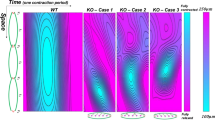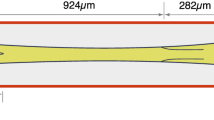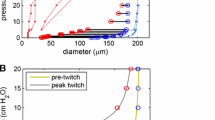Abstract
The transport of lymph through the lymphatic vasculature is the mechanism for returning excess interstitial fluid to the circulatory system, and it is essential for fluid homeostasis. Collecting lymphatic vessels comprise a significant portion of the lymphatic vasculature and are divided by valves into contractile segments known as lymphangions. Despite its importance, lymphatic transport in collecting vessels is not well understood. We present a computational model to study lymph flow through chains of valved, contracting lymphangions. We used the Navier–Stokes equations to model the fluid flow and the immersed boundary method to handle the two-way, fluid–structure interaction in 2D, non-axisymmetric simulations. We used our model to evaluate the effects of chain length, contraction style, and adverse axial pressure difference (AAPD) on cycle-mean flow rates (CMFRs). In the model, longer lymphangion chains generally yield larger CMFRs, and they fail to generate positive CMFRs at higher AAPDs than shorter chains. Simultaneously contracting pumps generate the largest CMFRs at nearly every AAPD and for every chain length. Due to the contraction timing and valve dynamics, non-simultaneous pumps generate lower CMFRs than the simultaneous pumps; the discrepancy diminishes as the AAPD increases. Valve dynamics vary with the contraction style and exhibit hysteretic opening and closing behaviors. Our model provides insight into how contraction propagation affects flow rates and transport through a lymphangion chain.














Similar content being viewed by others
Notes
We use the term “source” liberally throughout this work to obviate the need for repeating “source or sink”.
By virtual, we describe something that is implicitly rather than explicitly included in the physical model domain.
References
Adair TH, Guyton AC (1983) Modification of lymph by lymph nodes. II. Effect of increased lymph node venous blood pressure. Am J Physiol Circ Physiol 245(4):H616–H622. https://doi.org/10.1152/ajpheart.1983.245.4.H616
Akl TJ, Coté GL, Nepiyushchikh ZV, Gashev AA, Zawieja DC (2011) Measuring contraction propagation and localizing pacemaker cells using high speed video microscopy. J Biomed Opt 16(2):1–9. https://doi.org/10.1117/1.3544512
Arthurs KM, Moore LC, Peskin CS, Pitman E, Layton HE (1998) Modeling arteriolar flow and mass transport using the immersed boundary method. J Comput Phys 147(2):402–440. https://doi.org/10.1006/jcph.1998.6097
Ballard M, Wolf KT, Nepiyushchikh Z, Dixon JB, Alexeev A (2018) Probing the effect of morphology on lymphatic valve dynamic function. Biomech Model Mechanobiol 17(5):1343–1356. https://doi.org/10.1007/s10237-018-1030-y
Battista NA, Lane AN, Liu J, Miller LA (2017) Fluid dynamics in heart development: effects of hematocrit and trabeculation. Math Med Biol A J IMA 35(4):493–516. https://doi.org/10.1093/imammb/dqx018
Bazigou E, Xie S, Chen C, Weston A, Miura N, Sorokin L, Adams R, Muro AF, Sheppard D, Makinen T (2009) Integrin-\(\alpha\)9 is required for fibronectin matrix assembly during lymphatic valve morphogenesis. Dev Cell 17(2):175–186. https://doi.org/10.1016/j.devcel.2009.06.017
Benoit JN, Zawieja DC, Goodman AH, Granger HJ (1989) Characterization of intact mesenteric lymphatic pump and its responsiveness to acute edemagenic stress. Am J Physiol Circ Physiol 257(6):H2059–H2069. https://doi.org/10.1152/ajpheart.1989.257.6.H2059
Bertram CD (2020) Modelling secondary lymphatic valves with a flexible vessel wall: how geometry and material properties combine to provide function. Biomech Model Mechanobiol 19(6):2081–2098. https://doi.org/10.1007/s10237-020-01325-4
Bertram CD, Macaskill C, Moore JE Jr (2011) Simulation of a chain of collapsible contracting lymphangions with progressive valve closure. J Biomech Eng 133(1):011008. https://doi.org/10.1115/1.4002799
Bertram CD, Macaskill C, Davis MJ, Moore JE Jr (2014a) Development of a model of a multi-lymphangion lymphatic vessel incorporating realistic and measured parameter values. Biomech Model Mechanobiol 13(2):401–416. https://doi.org/10.1007/s10237-013-0505-0
Bertram CD, Macaskill C, Moore JE Jr (2014b) Incorporating measured valve properties into a numerical model of a lymphatic vessel. Comput Methods Biomech Biomed Engin 17(14):1519–1534. https://doi.org/10.1080/10255842.2012.753066
Bertram CD, Macaskill C, Davis MJ, Moore JE Jr (2016) Consequences of intravascular lymphatic valve properties: a study of contraction timing in a multi-lymphangion model. Am J Physiol Circ Physiol 310(7):H847–H860. https://doi.org/10.1152/ajpheart.00669.2015
Bertram CD, Macaskill C, Davis MJ, Moore JE Jr (2017) Valve-related modes of pump failure in collecting lymphatics: numerical and experimental investigation. Biomech Model Mechanobiol 16(6):1987–2003. https://doi.org/10.1007/s10237-017-0933-3
Bertram CD, Macaskill C, Davis MJ, Moore JE Jr (2018) Contraction of collecting lymphatics: organization of pressure-dependent rate for multiple lymphangions. Biomech Model Mechanobiol 17(5):1513–1532. https://doi.org/10.1007/s10237-018-1042-7
Beyer RP (1992) A computational model of the cochlea using the immersed boundary method. J Comput Phys 98(1):145–162. https://doi.org/10.1016/0021-9991(92)90180-7
Bohlen HG, Wang W, Gashev A, Gasheva O, Zawieja D (2009) Phasic contractions of rat mesenteric lymphatics increase basal and phasic nitric oxide generation in vivo. Am J Physiol Circ Physiol 297(4):H1319–H1328. https://doi.org/10.1152/ajpheart.00039.2009
Bridenbaugh EA, Nizamutdinova IT, Jupiter D, Nagai T, Thangaswamy S, Chatterjee V, Gashev AA (2013) Lymphatic muscle cells in rat mesenteric lymphatic vessels of various ages. Lymphat Res Biol 11(1):35–42. https://doi.org/10.1089/lrb.2012.0025
Caulk AW, Dixon JB, Gleason RL Jr (2016) A lumped parameter model of mechanically mediated acute and long-term adaptations of contractility and geometry in lymphatics for characterization of lymphedema. Biomech Model Mechanobiol 15(6):1601–1618. https://doi.org/10.1007/s10237-016-0785-2
Crowe MJ, von der Weid PY, Brock JA, Van Helden DF (1997) Co-ordination of contractile activity in guinea-pig mesenteric lymphatics. J Physiol 500(1):235–244. https://doi.org/10.1113/jphysiol.1997.sp022013
Davis MJ, Davis AM, Ku CW, Gashev AA (2009a) Myogenic constriction and dilation of isolated lymphatic vessels. Am J Physiol Circ Physiol 296(2):H293–H302. https://doi.org/10.1152/ajpheart.01040.2008
Davis MJ, Davis AM, Lane MM, Ku CW, Gashev AA (2009b) Rate-sensitive contractile responses of lymphatic vessels to circumferential stretch. J Physiol 587(1):165–182. https://doi.org/10.1113/jphysiol.2008.162438
Davis MJ, Rahbar E, Gashev AA, Zawieja DC, Moore JE Jr (2011) Determinants of valve gating in collecting lymphatic vessels from rat mesentery. Am J Physiol Circ Physiol 301(1):H48–H60. https://doi.org/10.1152/ajpheart.00133.2011
Davis MJ, Scallan JP, Wolpers JH, Muthuchamy M, Gashev AA, Zawieja DC (2012) Intrinsic increase in lymphangion muscle contractility in response to elevated afterload. Am J Physiol Circ Physiol 303(7):H795–H808. https://doi.org/10.1152/ajpheart.01097.2011
Dillon R, Fauci L, Gaver D III (1995) A microscale model of bacterial swimming, chemotaxis and substrate transport. J Theor Biol 177(4):325–340. https://doi.org/10.1006/jtbi.1995.0251
Dillon R, Fauci L, Fogelson A, Gaver D III (1996) Modeling biofilm processes using the immersed boundary method. J Comput Phys 129(1):57–73. https://doi.org/10.1006/jcph.1996.0233
Dixon JB, Greiner ST, Gashev AA, Cote GL, Moore JE Jr, Zawieja DC (2006) Lymph flow, shear stress, and lymphocyte velocity in rat mesenteric prenodal lymphatics. Microcirculation 13(7):597–610. https://doi.org/10.1080/10739680600893909
Fauci LJ, McDonald A (1995) Sperm motility in the presence of boundaries. Bull Math Biol 57(5):679–699. https://doi.org/10.1016/0021-9991(88)90158-1
Fauci LJ, Peskin CS (1988) A computational model of aquatic animal locomotion. J Comput Phys 77(1):85–108. https://doi.org/10.1016/0021-9991(88)90158-1
Fogelson AL (1984) A mathematical model and numerical method for studying platelet adhesion and aggregation during blood clotting. J Comput Phys 56(1):111–134. https://doi.org/10.1016/0021-9991(84)90086-X
Fogelson AL, Guy RD (2008) Immersed-boundary-type models of intravascular platelet aggregation. Comput Methods Appl Mech Eng 197(25):2087–2104. https://doi.org/10.1016/j.cma.2007.06.030
Gashev AA, Davis MJ, Zawieja DC (2002) Inhibition of the active lymph pump by flow in rat mesenteric lymphatics and thoracic duct. J Physiol 540(3):1023–1037. https://doi.org/10.1113/jphysiol.2001.016642
Hald BO, Castorena-Gonzalez JA, Zawieja SD, Gui P, Davis MJ (2018) Electrical communication in lymphangions. Biophys J 115(5):936–949. https://doi.org/10.1016/j.bpj.2018.07.033
Hamlet CL, Hoffman KA, Tytell ED, Fauci LJ (2018) The role of curvature feedback in the energetics and dynamics of lamprey swimming: a closed-loop model. PLoS Comput Biol 14(8):1–29. https://doi.org/10.1371/journal.pcbi.1006324
Harlow FH, Welch JE (1965) Numerical calculation of time-dependent viscous incompressible flow of fluid with free surface. Phys Fluids 8(12):2182–2189. https://doi.org/10.1063/1.1761178
Hoover A, Miller L (2015) A numerical study of the benefits of driving jellyfish bells at their natural frequency. J Theor Biol 374:13–25. https://doi.org/10.1016/j.jtbi.2015.03.016
Iyer D, Jannaway M, Yang Y, Scallan JP (2020) Lymphatic valves and lymph flow in cancer-related lymphedema. Cancers (Basel) 12(8):2297
Jamalian S, Bertram CD, Richardson WJ, Moore JE Jr (2013) Parameter sensitivity analysis of a lumped-parameter model of a chain of lymphangions in series. Am J Physiol Circ Physiol 305(12):H1709–H1717. https://doi.org/10.1152/ajpheart.00403.2013
Jamalian S, Davis MJ, Zawieja DC, Moore JE Jr (2016) Network scale modeling of lymph transport and its effective pumping parameters. PLoS One 11(2):1–18. https://doi.org/10.1371/journal.pone.0148384
Jamalian S, Jafarnejad M, Zawieja SD, Bertram CD, Gashev AA, Zawieja DC, Davis MJ, Moore JE Jr (2017) Demonstration and analysis of the suction effect for pumping lymph from tissue beds at subatmospheric pressure. Sci Rep 7(1):12080. https://doi.org/10.1038/s41598-017-11599-x
Knox P, Pflug JJ (1983) The effect of the canine popliteal node on the composition of lymph. J Physiol 345(1):1–14. https://doi.org/10.1113/jphysiol.1983.sp014961
Kou W, Griffith BE, Pandolfino JE, Kahrilas PJ, Patankar NA (2017) A continuum mechanics-based musculo-mechanical model for esophageal transport. J Comput Phys 348:433–459. https://doi.org/10.1016/j.jcp.2017.07.025
Kunert C, Baish JW, Liao S, Padera TP, Munn LL (2015) Mechanobiological oscillators control lymph flow. Proc Natl Acad Sci 112(35):10938–10943. https://doi.org/10.1073/pnas.1508330112
Lapinski PE, Lubeck BA, Chen D, Doosti A, Zawieja SD, Davis MJ, King PD (2017) RASA1 regulates the function of lymphatic vessel valves in mice. J Clin Invest 127(7):2569–2585. https://doi.org/10.1172/JCI89607
Lee JH, Rygg AD, Kolahdouz EM, Rossi S, Retta SM, Duraiswamy N, Scotten LN, Craven BA, Griffith BE (2020) Fluid–structure interaction models of bioprosthetic heart valve dynamics in an experimental pulse duplicator. Ann Biomed Eng 48(5):1475–1490. https://doi.org/10.1007/s10439-020-02466-4
LeVeque RJ (2007) Finite difference methods for ordinary and partial differential equations: steady-state and time-dependent problems. Other titles in applied mathematics. Society for Industrial and Applied Mathematics
Li H, Mei Y, Maimon N, Padera TP, Baish JW, Munn LL (2019) The effects of valve leaflet mechanics on lymphatic pumping assessed using numerical simulations. Sci Rep 9(1):10649. https://doi.org/10.1038/s41598-019-46669-9
Lim S, Peskin CS (2012) Fluid–mechanical interaction of flexible bacterial flagella by the immersed boundary method. Phys Rev E 85(3):36307. https://doi.org/10.1103/PhysRevE.85.036307
Macdonald AJ, Arkill KP, Tabor GR, McHale NG, Winlove CP (2008) Modeling flow in collecting lymphatic vessels: one-dimensional flow through a series of contractile elements. Am J Physiol Circ Physiol 295(1):H305–H313. https://doi.org/10.1152/ajpheart.00004.2008
Margaris K, Nepiyushchikh Z, Zawieja D, Moore J Jr, Black AR (2016) Microparticle image velocimetry approach to flow measurements in isolated contracting lymphatic vessels. J Biomed Opt 21:25002. https://doi.org/10.1117/1.JBO.21.2.025002
McHale NG, Meharg MK (1992) Co-ordination of pumping in isolated bovine lymphatic vessels. J Physiol 450:503–512. https://doi.org/10.1113/jphysiol.1992.sp019139
McHale NG, Roddie IC (1976) The effect of transmural pressure on pumping activity in isolated bovine lymphatic vessels. J Physiol 261(2):255–269. https://doi.org/10.1113/jphysiol.1976.sp011557
Miller LA, Peskin CS (2004) When vortices stick: an aerodynamic transition in tiny insect flight. J Exp Biol 207(17):3073–3088. https://doi.org/10.1242/jeb.01138
Miller LA, Peskin CS (2005) A computational fluid dynamics of ‘clap and fling’ in the smallest insects. J Exp Biol 208(2):195–212
Moore J, Bertram CD (2018) Lymphatic system flows. Annu Rev Fluid Mech 50(1):459–482. https://doi.org/10.1146/annurev-fluid-122316-045259
Mukherjee A, Hooks J, Nepiyushchikh Z, Dixon JB (2019) Entrainment of lymphatic contraction to oscillatory flow. Sci Rep 9(1):5840. https://doi.org/10.1038/s41598-019-42142-9
Peskin CS (1972) Flow patterns around heart valves: a numerical method. J Comput Phys 10(2):252–271. https://doi.org/10.1016/0021-9991(72)90065-4
Peskin CS (1977) Numerical analysis of blood flow in the heart. J Comput Phys 25(3):220–252. https://doi.org/10.1016/0021-9991(77)90100-0
Peskin CS (2002) The immersed boundary method. Acta Numer 11:479–517. https://doi.org/10.1017/S0962492902000077
Peskin CS (2007) Energy functions for the representation of immersed elastic boundaries. https://www.math.nyu.edu/faculty/peskin/ib_lecture_notes/lecture3.pdf
Quick CM, Venugopal AM, Gashev AA, Zawieja DC, Stewart RH (2007) Intrinsic pump-conduit behavior of lymphangions. Am J Physiol Integr Comp Physiol 292(4):R1510–R1518. https://doi.org/10.1152/ajpregu.00258.2006
Rahbar E, Moore J (2011) A model of a radially expanding and contracting lymphangion. J Biomech 44(6):1001–1007. https://doi.org/10.1016/j.jbiomech.2011.02.018
Rahbar E, Weimer J, Gibbs H, Yeh A, Bertram CD, Davis MJ, Hill M, Zawieja D, Moore JE Jr (2012) Passive pressure–diameter relationship and structural composition of rat mesenteric lymphangions. Lymphat Res Biol 10:152–163. https://doi.org/10.1089/lrb.2011.0015
Razavi MS, Nelson TS, Nepiyushchikh Z, Gleason RL, Dixon JB (2017) The relationship between lymphangion chain length and maximum pressure generation established through in vivo imaging and computational modeling. Am J Physiol Circ Physiol 313(6):H1249–H1260. https://doi.org/10.1152/ajpheart.00003.2017
Reddy NP, Krouskop TA, Newell PH Jr (1975) Biomechanics of a lymphatic vessel. Blood Vessels 12(5):261–278. https://doi.org/10.1159/000158062
Reddy NP, Krouskop TA, Newell PH Jr (1977) A computer model of the lymphatic system. Comput Biol Med 7(3):181–197. https://doi.org/10.1016/0010-4825(77)90023-3
Renkin EM (1986) Some consequences of capillary permeability to macromolecules: Starling’s hypothesis reconsidered. Am J Physiol Circ Physiol 250(5):H706–H710. https://doi.org/10.1152/ajpheart.1986.250.5.H706
Rockson SG (2001) Lymphedema. Am J Med 110(4):288–295. https://doi.org/10.1016/S0002-9343(00)00727-0
Scallan JP, Wolpers JH, Muthuchamy M, Zawieja DC, Gashev AA, Davis MJ (2012) Independent and interactive effects of preload and afterload on the pump function of the isolated lymphangion. Am J Physiol Circ Physiol 303(7):H809–H824. https://doi.org/10.1152/ajpheart.01098.2011
Scallan JP, Wolpers JH, Davis MJ (2013) Constriction of isolated collecting lymphatic vessels in response to acute increases in downstream pressure. J Physiol 591(2):443–459. https://doi.org/10.1113/jphysiol.2012.237909
Scallan JP, Zawieja SD, Castorena-Gonzalez JA, Davis MJ (2016) Lymphatic pumping: mechanics, mechanisms and malfunction. J Physiol 594(20):5749–5768. https://doi.org/10.1113/JP272088
Schmid-Schonbein GW (1990) Microlymphatics and lymph flow. Physiol Rev 70(4):987–1028. https://doi.org/10.1152/physrev.1990.70.4.987
Shields JD, Fleury ME, Yong C, Tomei AA, Randolph GJ, Swartz MA (2007) Autologous chemotaxis as a mechanism of tumor cell homing to lymphatics via interstitial flow and autocrine CCR7 signaling. Cancer Cell 11(6):526–538. https://doi.org/10.1016/j.ccr.2007.04.020
Swartz MA, Lund AW (2012) Lymphatic and interstitial flow in the tumour microenvironment: linking mechanobiology with immunity. Nat Rev Cancer 12(3):210–219. https://doi.org/10.1038/nrc3186
Vajda J, Tomcsik M (1971) The structure of the valves of the lymphatic vessels. Cells Tissues Organs 78(4):521–531. https://doi.org/10.1159/000143611
Venugopal AM, Stewart RH, Laine GA, Dongaonkar RM, Quick CM (2007) Lymphangion coordination minimally affects mean flow in lymphatic vessels. Am J Physiol Circ Physiol 293(2):H1183–H1189. https://doi.org/10.1152/ajpheart.01340.2006
Watson DJ, Sazonov I, Zawieja DC, Moore JE Jr, van Loon R (2017) Integrated geometric and mechanical analysis of an image-based lymphatic valve. J Biomech 64:172–179. https://doi.org/10.1016/j.jbiomech.2017.09.040
Wiig H, Swartz MA (2012) Interstitial fluid and lymph formation and transport: physiological regulation and roles in inflammation and cancer. Physiol Rev 92(3):1005–1060. https://doi.org/10.1152/physrev.00037.2011
Wilson JT, Wang W, Hellerstedt AH, Zawieja DC, Moore JE Jr (2013) Confocal image-based computational modeling of nitric oxide transport in a rat mesenteric lymphatic vessel. J Biomech Eng 135(5):51005. https://doi.org/10.1115/1.4023986
Wilson JT, van Loon R, Wang W, Zawieja DC, Moore JE Jr (2015) Determining the combined effect of the lymphatic valve leaflets and sinus on resistance to forward flow. J Biomech 48(13):3584–3590. https://doi.org/10.1016/j.jbiomech.2015.07.045
Wilson JT, Edgar LT, Prabhakar S, Horner M, van Loon R, Moore JE Jr (2018) A fully coupled fluid–structure interaction model of the secondary lymphatic valve. Comput Methods Biomech Biomed Eng 21(16):813–823. https://doi.org/10.1080/10255842.2018.1521964
Zawieja DC (2009) Contractile physiology of lymphatics. Lymphat Res Biol 7(2):87–96. https://doi.org/10.1089/lrb.2009.0007
Zawieja DC, Davis KL, Schuster R, Hinds WM, Granger HJ (1993) Distribution, propagation, and coordination of contractile activity in lymphatics. Am J Physiol Circ Physiol 264(4):H1283–H1291. https://doi.org/10.1152/ajpheart.1993.264.4.H1283
Zawieja SD, Castorena-Gonzalez JA, Scallan JP, Davis MJ (2018) Differences in L-type Ca2+ channel activity partially underlie the regional dichotomy in pumping behavior by murine peripheral and visceral lymphatic vessels. Am J Physiol Circ Physiol 314(5):H991–H1010. https://doi.org/10.1152/ajpheart.00499.2017
Zhang R, Taucer AI, Gashev AA, Muthuchamy M, Zawieja DC, Davis MJ (2013) Maximum shortening velocity of lymphatic muscle approaches that of striated muscle. Am J Physiol Circ Physiol 305(10):H1494–H1507. https://doi.org/10.1152/ajpheart.00898.2012
Zweifach BW, Prather JW (1975) Micromanipulation of pressure in terminal lymphatics in the mesentery. Am J Physiol Content 228(5):1326–1335. https://doi.org/10.1152/ajplegacy.1975.228.5.1326
Acknowledgements
Simulations were run at the Center for High-Performance Computing (CHPC) at the University of Utah. HE acknowledges partial support under NSF RTG-1148230. ALF was supported in part by NSF grant DMS-1716898. ALF and AB were supported in part by NHLBI grant 1U01HL143336. VS was supported by grant NSF CCF 1714844.
Author information
Authors and Affiliations
Corresponding author
Ethics declarations
Conflict of interest
The authors declare that they have no conflict of interest.
Additional information
Publisher's Note
Springer Nature remains neutral with regard to jurisdictional claims in published maps and institutional affiliations.
Supplementary Information
Below is the link to the electronic supplementary material.
Supplementary material 3 (mov 25028 KB)
Supplementary material 4 (mov 25306 KB)
Supplementary material 5 (mov 24641 KB)
Supplementary material 6 (mov 23467 KB)
Supplementary material 7 (mov 22730 KB)
Supplementary material 8 (mov 24538 KB)
Supplementary material 9 (mov 1593 KB)
Supplementary material 10 (mov 7522 KB)
Supplementary material 11 (mov 8019 KB)
Supplementary material 12 (mov 7339 KB)
Supplementary material 13 (mov 7314 KB)
Supplementary material 14 (mov 6964 KB)
Supplementary material 15 (mov 6951 KB)
Supplementary material 16 (mov 7739 KB)
Supplementary material 17 (mov 7904 KB)
Supplementary material 18 (mov 7748 KB)
Supplementary material 19 (mov 7407 KB)
Supplementary material 20 (mov 7970 KB)
Supplementary material 21 (mov 8078 KB)
Rights and permissions
About this article
Cite this article
Elich, H., Barrett, A., Shankar, V. et al. Pump efficacy in a two-dimensional, fluid–structure interaction model of a chain of contracting lymphangions. Biomech Model Mechanobiol 20, 1941–1968 (2021). https://doi.org/10.1007/s10237-021-01486-w
Received:
Accepted:
Published:
Issue Date:
DOI: https://doi.org/10.1007/s10237-021-01486-w




